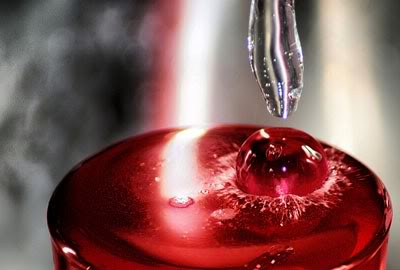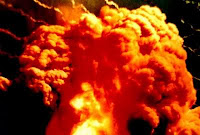Red Mercury
Alixeiralohmr
This enigma is said that knowledge of foot pre-Christmas and Toratth the Middle Ages and remained for the time being the mystery of the mysteries of life!!
Baffled scientists and sold him a bottle of $ 27 million
Red mercury to extract the treasures of the earth and of nuclear fission
What is known about red mercury?
Houshi rare, but more than rare, it costs millions and his name could lead to the summit or the abyss.
Story linked to the past and also recently in the Jinn and devils and treasures. But in fact much more serious, particularly as it enters directly in the manufacture of sophisticated weapons and is included in the manufacture of various kinds of activity peaks.
Red mercury is a new nuclear material has been discovered in Russia as a mediator for the production of explosives is more effective than uranium 235 and plutonium 239,
The name for the red mercury liquid can be used in the production of atomic weapons ..
Physical properties of red mercury:
Melting point -37.8
Molecular weight 756.6
Density of 20.2 gm \ cc
Chemical formula:
Hg2Sb2O7
Specifications:
It is said that red mercury is a semi-liquid material red.
The intensity of red mercury is very high about 20.2 g / cm 3, which like the intensity Alneptinyum 237 as they are a non-radioactive.
Since the amount of potential chemical energy molecule limited the increase in component density lead to efficient explosively be more effective.
And the intensity of any explosive substance has particular significance when considering the speed and burst pressure of the article.
It is known that when you get an explosive substance with a density twice the density of material, for example RDX per gram while maintaining the same energy content, you get something that leads to Taqpanfjarip bigger than any of explosive materials currently known.
Red uses of mercury
Red Mercury is used as a solvent for the uranium-235 and thus facilitate the process of storing radioactive uranium 235 and this can be easily separated from the red mercury by a process of distillation, is well known that mercury was ten matches, seven of which were stable, then unstable isotope, and beta rays produce two equals negative, and one of these isotopes for industrial Mercury is known as the Red
The natural counterpart Vlonh silver tends to be reddish, while the industrial counterpart Venzirh tends to color with red oxide of mercury being Metallic. Consequently this industrial counterpart of a critical mass of between (2:3) kilograms and can blow up several grams of it, concrete, It's a parallel first-class military, and most of it is located now in the world in the production of the former Soviet Union.
Red mercury is a hazardous substance with it apparently is not explosive itself is used as a source of neutrons that are running on the contents of the pressure of the atomic bomb, deuterium and tritium to the top of the critical mass, and when there is explosive device it produces a violent explosion accompanied by the destruction of an area with a radius of 600 Mtermn bomb size of about 500 cm 3 (about 10 kg), where flood area Benitronat Fast remain about two days this is an important strategic development of the neutron bomb.
Red mercury is also used as a mobilization of both plutonium and tritium in neutron bomb neutron radiation where it starts.
When We have red mercury with tritium gas for a while it works to generate fusion energy that lead to the production of an enormous amount of nuclear energy.
And an expert on U.S. nuclear weapons Sam Cohen, who participated in the invention of the neutron bomb when asked about the idea of the integration of Red Mercury, he said that red mercury is a compound of the large density of energy and in any case the Russians have succeeded in the manufacture of this compound, using high-pressure technology Extraordinary.
Red mercury and explosive force is too large to the extent that it can begin fusion reaction in an atomic bomb.
And when it starts, all of these electrons from mercury red to the outside, it occurs a change of the atom and the resulting amount of energy per gram of red mercury much higher than other explosives known and heard of it.
Fact that red mercury
Was signed between the hands of the British investigative journalist, "Gwynne Roberts," a report prepared for the attention of "Eugenie"
Russian Foreign Minister, who at the time the head of the Iz a Russian intelligence, the fact of mercury red.
This was mentioned by the report that what was known as the Soviet Union began the production of such material in 1968 at the "Dubna" of nuclear research, chemists and specialists know that this article
Symbol (h925 b206) density of a substance (20.2) grams per cubic centimeter.
This has created a high degree of intensity confusion in the minds of Western scholars, as it is higher than the density of any material known in the world, including minerals water.
It is known that the density of mercury used in measuring the temperature of (6.13) grams per cubic centimeter, with a density of pure plutonium slightly less than (20) grams per
Per cubic centimeter.
Indeed, many researchers in archeology that there are already so-called "red mercury", a
Semi-liquid substance in red, is still used in processes relevant to nuclear fission and the source of manufacturing for export to countries in the world is some of the former Soviet Union, as are some of the smuggling gangs inside nuclear reactors are to be sold in millions of dollars in some of the world.
Alixeiralohmr
This enigma is said that knowledge of foot pre-Christmas and Toratth the Middle Ages and remained for the time being the mystery of the mysteries of life!!
Baffled scientists and sold him a bottle of $ 27 million
Red mercury to extract the treasures of the earth and of nuclear fission
What is known about red mercury?

Houshi rare, but more than rare, it costs millions and his name could lead to the summit or the abyss.
Story linked to the past and also recently in the Jinn and devils and treasures. But in fact much more serious, particularly as it enters directly in the manufacture of sophisticated weapons and is included in the manufacture of various kinds of activity peaks.
Red mercury is a new nuclear material has been discovered in Russia as a mediator for the production of explosives is more effective than uranium 235 and plutonium 239,
The name for the red mercury liquid can be used in the production of atomic weapons ..
Physical properties of red mercury:
Melting point -37.8
Molecular weight 756.6
Density of 20.2 gm \ cc
Chemical formula:
Hg2Sb2O7
Specifications:
It is said that red mercury is a semi-liquid material red.
The intensity of red mercury is very high about 20.2 g / cm 3, which like the intensity Alneptinyum 237 as they are a non-radioactive.
Since the amount of potential chemical energy molecule limited the increase in component density lead to efficient explosively be more effective.
And the intensity of any explosive substance has particular significance when considering the speed and burst pressure of the article.
It is known that when you get an explosive substance with a density twice the density of material, for example RDX per gram while maintaining the same energy content, you get something that leads to Taqpanfjarip bigger than any of explosive materials currently known.
Red uses of mercury
Red Mercury is used as a solvent for the uranium-235 and thus facilitate the process of storing radioactive uranium 235 and this can be easily separated from the red mercury by a process of distillation, is well known that mercury was ten matches, seven of which were stable, then unstable isotope, and beta rays produce two equals negative, and one of these isotopes for industrial Mercury is known as the Red
The natural counterpart Vlonh silver tends to be reddish, while the industrial counterpart Venzirh tends to color with red oxide of mercury being Metallic. Consequently this industrial counterpart of a critical mass of between (2:3) kilograms and can blow up several grams of it, concrete, It's a parallel first-class military, and most of it is located now in the world in the production of the former Soviet Union.
Red mercury is a hazardous substance with it apparently is not explosive itself is used as a source of neutrons that are running on the contents of the pressure of the atomic bomb, deuterium and tritium to the top of the critical mass, and when there is explosive device it produces a violent explosion accompanied by the destruction of an area with a radius of 600 Mtermn bomb size of about 500 cm 3 (about 10 kg), where flood area Benitronat Fast remain about two days this is an important strategic development of the neutron bomb.
Red mercury is also used as a mobilization of both plutonium and tritium in neutron bomb neutron radiation where it starts.
When We have red mercury with tritium gas for a while it works to generate fusion energy that lead to the production of an enormous amount of nuclear energy.
And an expert on U.S. nuclear weapons Sam Cohen, who participated in the invention of the neutron bomb when asked about the idea of the integration of Red Mercury, he said that red mercury is a compound of the large density of energy and in any case the Russians have succeeded in the manufacture of this compound, using high-pressure technology Extraordinary.
Red mercury and explosive force is too large to the extent that it can begin fusion reaction in an atomic bomb.
And when it starts, all of these electrons from mercury red to the outside, it occurs a change of the atom and the resulting amount of energy per gram of red mercury much higher than other explosives known and heard of it.
Fact that red mercury
Was signed between the hands of the British investigative journalist, "Gwynne Roberts," a report prepared for the attention of "Eugenie"
Russian Foreign Minister, who at the time the head of the Iz a Russian intelligence, the fact of mercury red.
This was mentioned by the report that what was known as the Soviet Union began the production of such material in 1968 at the "Dubna" of nuclear research, chemists and specialists know that this article
Symbol (h925 b206) density of a substance (20.2) grams per cubic centimeter.
This has created a high degree of intensity confusion in the minds of Western scholars, as it is higher than the density of any material known in the world, including minerals water.
It is known that the density of mercury used in measuring the temperature of (6.13) grams per cubic centimeter, with a density of pure plutonium slightly less than (20) grams per
Per cubic centimeter.
Indeed, many researchers in archeology that there are already so-called "red mercury", a
Semi-liquid substance in red, is still used in processes relevant to nuclear fission and the source of manufacturing for export to countries in the world is some of the former Soviet Union, as are some of the smuggling gangs inside nuclear reactors are to be sold in millions of dollars in some of the world.




